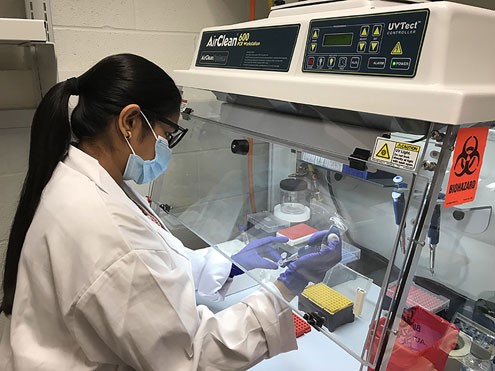Using DNA to search for the true origins of imported honey
By Department of Homeland Security (DHS) Science and Technology Directorate
Have you ever wondered where the honey you add to your morning tea and drizzle on your desserts or oatmeal comes from (besides bees)? The easy answer would be to check the label, which typically offers the country of origin along with all those wonderful nutritional benefits. Unfortunately, as the Department of Homeland Security’s Science and Technology Directorate (S&T) knows all too well, sometimes labels can be misleading, especially when it comes to honey imported into the U.S.
University of Houston graduate student Dimple Chavan prepares manuka honey samples for a DNA sequencing test. photo by BTI
Honey imports have nearly doubled in the last decade—from 251 million pounds in 2010 to 416 million pounds in 2019—which is great news for consumers who now have more access to some of the sweetest stuff on earth. However, this tremendous growth in demand also has a dark side that many might not know about—adulteration and mislabeling of honey to hide its true origin have become a global issue.
What does this mean for shoppers and our economy? Well, illicit importers, who are economically motivated to evade tariffs or sanctions, have made it a practice to affix fake labels onto jars, indicating the honey is from a different country of origin or disguising cheaper honey as sought-after expensive types. Some illicit actors even dilute honey with ingredients like syrups and sugar. New Zealand manuka honey, for example, commands a high price on the market, up to 100 times higher than other honey types, as it is very in-demand for its putative health benefits. It is also one of the most adulterated types of honey. In a recent lawsuit, U.S. beekeepers claimed adulterated honey from Asia caused prices to plummet and forced them into financial ruin.
“Adulterated honey is a tremendous problem for the U.S. honey industry, because it drives the market price down, and U.S. producers can’t compete with the lower market value of imported honey,” said Stephen Cassata, a senior science officer and acting lab director of the U.S. Customs and Border Protection (CBP) INTERDICT Science Center. “Dealing with this issue is a whole-of-government approach, and we are currently collaborating with other federal agencies (including the Food and Drug Administration and U.S. Department of Agriculture) on joint operations targeting honey enforcement.”
CBP is tasked with enforcing hundreds of U.S. trade laws, including the proper classification of goods under the Harmonized Tariff Schedule of the United States, and assessing applicable tariffs to ensure that importers pay the appropriate duties on entered goods. To help CBP determine the true sources of honey, S&T enlisted the expertise of the Borders, Trade, and Immigration Institute Center of Excellence (BTI), led by the University of Houston, for a project called Honey DNA. S&T invested in cutting-edge forensic science that can improve the speed and efficiency in verifying the country of origin of commercially available honey and its path to the supermarket shelves—specifically, S&T has been looking at how the unique makeups of products coming to the U.S. match how they are represented on the packaging.
“This project developed a means to identify honey countries of origin using the DNA in pollen and DNA dissolved in filtered honey,” said BTI executive director Kurt Berens.
Honey is filtered for a variety of reasons, including the attempt to hide its source plant by making plant identification by pollen very challenging.
“BTI’s testing method could potentially provide another capability for CBP to determine country or region of origin for Antidumping and Countervailing Duty enforcement,” said CBP deputy director Patricia Hawes. “It complements testing capabilities we already employ to determine country of origin of honey.”
To read the complete article go to:
Using DNA to search for the true origins of imported honey – North Texas e-News (ntxe-news.com)









